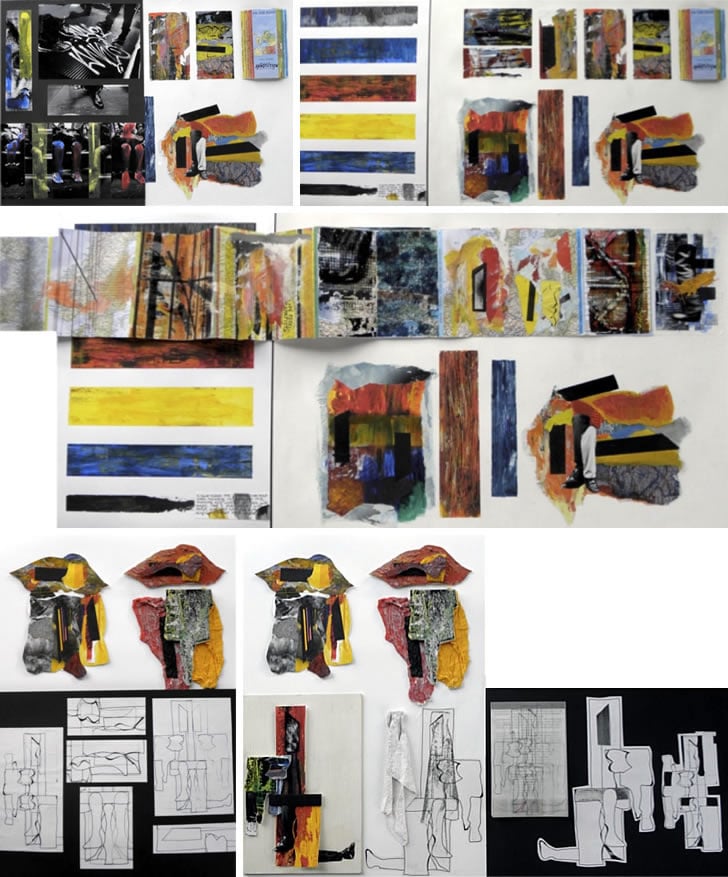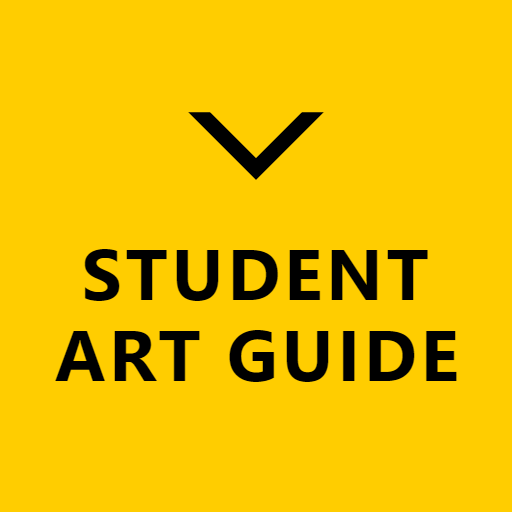Last Updated on April 2, 2023
This article presents an CIE IGCSE Art exam project by Enrico Giori, completed while studying Art and Design at St. Louis High School, Milan, Italy for the June 2014 examination session. Enrico was awarded 97% (A*) overall. We have also published Enrico’s IGCSE Coursework project. Enrico writes about his Art examination below.
Two of Enrico’s sketchbook pages are included in our new book: Outstanding High School Sketchbooks. This book has high-resolution images so that fine details and annotation are clear, making it an excellent resource for students and schools. Learn more!

I started exploring the IGCSE Exam Topic Street Patterns by looking at the two words composing the title as individual terms. I therefore consulted the dictionary and examined the definitions of the words ‘street’ and ‘pattern’. I extrapolated the key term ‘public’ from the definition of ‘street’ (a public road in a city or town, typically with houses and buildings on one or both sides) and the term ‘repeated’ from the definition of ‘pattern’ (a repeated decorative design). From these two key terms I developed my exam project, following a conceptual framework, which enabled me to achieve 98 marks out of 100 for this component of my IGCSE qualification (I achieved overall a 97%, with 90 marks out of 100 in my Coursework component).
I started exploring the theme Street Patterns over the first week upon receipt of the examination paper by taking many photographs of the city I study in, Milan, and by keeping a little journal of quick sketches, which I used to start identifying patterns in the street. Railings, billboards, graffiti, subway lines and road signs all produced interesting patterns in the city, but these did not stimulate any thought in me. I therefore started examining closely people, their movements, their gestures and their clothes to identify patterns. I focused mainly on patterns which I could see every day when travelling to school, such as the peculiar arrangement of legs in the subway.
This conceptual twist in my work brought me to take photos of people’s legs, which I then used to study the variety of positions that a pair of legs can place itself into when sitting on the seat of the Milanese underground. I distorted, manipulated, isolated and explored the shapes of legs, and ended up with a variety of compositions which allowed me to start planning my examination piece.

I experimented with different mediums such as paint, collage, pencil, and pen and ink. My experimentation and subsequent critical analysis of it brought me to pursue the technique of assemblage, meaning creating a collage with relief elements. I also experimented with a wide variety of materials to investigate how they interact with each other: I find it breathtaking to observe how materials interact when used in different combination. Furthermore, I believe that exploring a wide range of materials allows for a development of knowledge on artistic mediums that can help immensely when producing work in the future.
Artist research is another element which has allowed me to successfully complete this component. I had the pleasure of speaking to an Italian artist who produces assemblages named Alfred Drago Rens and focused on his series of assemblages Tutto Quadra, showcased at the 2014 edition of the Milan Image Art Fair, an International Photo and Video fair which is acquiring more importance year after year in Italy. I also used Clyfford Still as an artist reference in my project, mainly because of the geometrical nature of his artwork and his vibrant colour choices.
The week before the exam I devoted my time to planning, refining and re-drafting a successful composition to use in my eight hour examination. I ended up with four separate ones, which I planned to create during the examination days. My final outcome was a set of four assemblages which show a progressive simplification of forms which I identified in my studies of people’s legs in the subway.

During the exam I realized that it is irrational to expect that what is planned beforehand will smoothly happen, leaving no room for unexpected events and problems. I found myself in situations where I was challenged to engage in problem solving, which is a skill that I advise any art – or non art – student to develop. Problem solving is what allowed me to follow through this whole IGCSE Art examination.
I have always admired conceptual art for its thought provoking nature, and decided to try and approach the IGCSE Observational/Interpretative assignment (Paper 1) with this idea in mind. I strongly believe that this very reason is why this project is achieved highly: it sets itself apart from the other projects which address the same prompt. It furthermore shows that it is not necessary to be an excellent observational drawing student to succeed at IGCSE Art and Design. Whilst I strongly understand the importance of observational drawing in Art, mainly thanks to my current Art teacher, I believe that depicting what is in front of us is not the sole purpose of Art: through art we ought to show others how we see the world around us, and we perhaps also have to show others small details that they do not notice when living the same, repetitive life day after day. One of my favorite designers, Charles Eames, once said that ‘The details are not the details. They make the design’ and I believe this quote reflects perfectly my approach to this IGCSE Examination project.
I also advise anyone studying Art at this moment in time to invest plenty of time planning their work, selecting ideas and methodically approaching their qualification. I have learned – and still am in the process of learning – that selectivity in Art is paramount to success. It is amazing to have thousands of ideas for one question, but being able to select the one idea that could potentially trigger the development of a whole project is what will ensure success at IGCSE and, even though teachers may aid in the process of selection, they are not to be seen as ‘decision makers’ for one’s qualification. I tried to develop a work ethic centred around independence and self-sustenance during my IGCSE exam project, which is helping me greatly now, as I am studying IB Visual Arts at Higher Level.
Did you enjoy viewing Enrico’s Art exam? You may also wish to view his A* IGCSE Art Coursework project.


